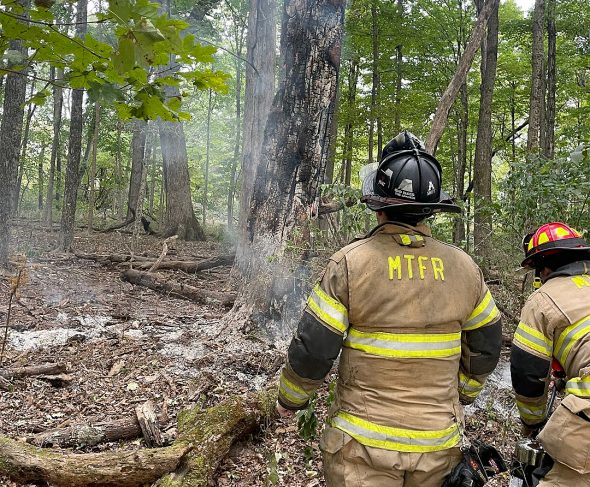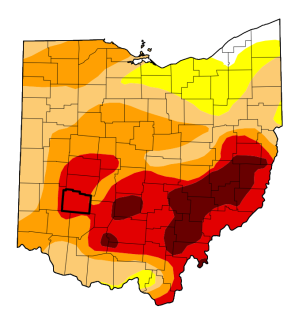
On Tuesday, Sept. 17, a small fire broke out in Glen Helen from a prohibited campsite in the preserve. Crews quickly contained and extinguished the blaze, which threatened to spread and cause significantly more damage to the Glen as a result of the ongoing, statewide drought. As of press time, all of Greene County is experiencing a “extreme” drought, as most recent classified by the U.S. Drought Monitor on Thursday, Sept. 19. (Photo courtesy of Glen Helen Nature Preserve)
Burn ban set for county as drought persists
- Published: September 19, 2024
ED. NOTE: On Thursday, Sept. 19, the U.S. Drought Monitoring System designated Greene County as being in the “Extreme Drought” category — the second highest in the system’s intensity categorization. Following this new designation, Ohio State Fire Marshal instated a burn ban for all of Greene County as well as all other Ohio counties experiencing “extreme” or “exceptional” drought conditions.
The following article, which went to print on Wednesday, Sept. 18, has been updated to reflect the those recent developments.
Around 8 a.m. on Tuesday, Sept. 17, a small fire broke out in Glen Helen Nature Preserve. It started at an off-trail campsite near the entrance of the nature preserve.
Though Miami Township Fire-Rescue and Village crews had the fire extinguished within 30 minutes, a few embers had already jumped to the base of a tall, dead ash tree. Glen Helen staffers felled the tree before the fire could spread any further. By 8:45 a.m., the situation was contained.
The Glen’s rules are clear: Camping is expressly prohibited, and visitors are to stay on the trails. What else is clear is why Tuesday’s momentary crisis was so dire: Yellow Springs, like 95% of Ohio, is in the midst of a weeks-long drought.
Per the most recent data from the U.S. Drought Monitor, the drought in Greene County is “extreme” — and as a result, the county is susceptible to fire.
“As conditions get drier, the risk of fire in Glen Helen increases,” Glen Helen Executive Director Nick Boutis told the News the morning of the fire. “It’s more important than ever that nobody introduces any incendiaries to the preserve and that people stay on the trails. Always approach an environment with the idea of leaving no trace.”
It’s not just Glen Helen that’s dried up in the last month.
Regional crops have browned, gardens wilted and trees have begun dropping leaves ahead of their typical fall defoliation. The worst conditions are in Southeast Ohio, where more than two dozen counties are experiencing “extreme” or “exceptional” drought conditions.
In addition to Greene County, close to half the state’s 88 counties are now under a burn ban.
Examples of activities prohibited by this the state ordained ban include those involving the lighting or maintaining of an open fire such as:
- Any open burning of trash, debris, waste, combustibles, leaf piles or similar vegetation
- Campfires and bonfires
- Throwing down or discarding lit or smoldering material, such as matches or cigarettes
- Using or discharging any type of fireworks
- Live-fire training events
- Flame effect(s) based displays or exhibitions, including sky lanterns and cold spark machines
- Using spark- or heat-producing devices for recreational purposes
“We want everyone to think before you do something involving any kind of open flame,” said Ohio State Fire Marshal Kevin Reardon in a recent press release. “We are in severe drought conditions and ground conditions are very susceptible to ignition from a very simple source. We want people to be able to protect themselves, protect their property, and protect their communities.”

The U.S. Department of Agriculture and the National the National Oceanic and Atmospheric Administration — the agencies that operate the U.S. Drought Monitor — have classified Greene County, shown here in bold, as experiencing “extreme drought,” which is the second highest classification in the monitor. Dark red indicates “exceptional drought,” the worst classification. The monitor was updated most recently on Thursday, Sept. 19.
According to the National Park Service, nearly 85% of wildfires are caused by humans, and some of the main causes are unattended campfires or bonfires, the burning of debris, and negligently discarded cigarettes.
Miami Township Fire-Rescue Chief Denny Powell told the News Thursday morning that Yellow Springs residents may not have outdoor fires until December.
Villagers, resources tested by heat
In spite of the ongoing drought, Yellow Springs residents, growers and business owners are persevering the best they can.
Molly Finch, owner of Goldfinch Garden Design, told the News that although the drought has made her work harder, it has reinforced her work’s importance.
“Climate change is real, and we need to move away from landscaping that demands more water,” Finch said, noting that her business model focuses on permaculture-based practices and native plants — the kind that, after getting established, can withstand and even thrive in occasional dry spells.
Still, she added: “Putting in over 1,000 native perennials and shrubs this season across several sites, and trying to keep everything watered while preparing new areas, has been pretty exhausting.”
Another local business owner, Tyler Fox of Fox Trot Services, told the News that while the drought hampered his usual landscaping, he’s still making do.
“We haven’t had to cut grass in three weeks,” Fox said. “We’ve had to switch gears to other things — bush trimming, deck building, fence building — jobs just to fill our empty time when we’d normally be cutting grass every day.”
Last Saturday morning was a relatively standard market day for Doug Seibert of Spring Valley-based Peach Mountain Organics. At the Yellow Springs 4 Season Farmers’ Market, Seibert’s garlic, peppers, tomatoes and flowers were vibrant and plump. But unlike in past years, the lifelong farmer had to cut his corn season short.
“I couldn’t justify my sweet corn getting so much water,” he told the News. “I just have more valuable things to water.”
Among those things, Seibert said, are local critters also looking to stay hydrated.
“We have this drip irrigation system that we use from time to time,” he said. “Now, this year, I got raccoons, I got crows — you name it — all poking holes in my irrigation because they’re so thirsty. I have to put out water dishes for these animals. Isn’t that crazy?”
Back in the Glen, other animals have changed their patterns amid the drought.
With streams down to a trickle and the Cascades mostly dried up, executive Director Boutis said he’s observed more critters than ever before crowding around the beaver-made wetland.
“It’s just abounding with wildlife,” Boutis said. “It’s become an oasis — which, as a birdwatcher, has been a lot of fun. I’ve seen some of the most unusual woodpecker species by the dam.”
Elsewhere in the Glen, Boutis noted, are more concerning effects from the drought. Deer are noticeably stressed and algae has begun proliferating. The many innumerable dead ash trees throughout the preserve are drier than ever — just like the one that firefighters had to douse and fell on Tuesday morning.
What of the taller and older members of the local plant community?
Villager Don Cipollini told the News that he’s observed some early senescence — or natural deterioration — and early ripening in local trees and flora.
Even with those concerning observations, the professor of biological sciences at Wright State University said he takes solace in the cyclical nature of dry and wet years.
“Obviously it’s getting hotter and hotter every year,” Cipollini said. “But this drought, even though it seems bad, is not overly extreme. This year doesn’t really stand out compared to 2012 and 2013. It’s perfectly normal to have two- to three-year periods of droughts, then two- to three-year periods of heavy precipitation.”
Cipollini also noted that while many trees are showing signs of stress, many of them are behaving just as they ought to: purposefully allowing their leaves to drop and dry up to conserve water as they respond to a shortened growing period. Next year, Cipollini said, local trees will likely grow and bloom as normal.
Most immediately, he offered a prediction: “Typical fall colors this year will not be as vibrant. Because of this drought, trees now have less time to accumulate carbohydrates and pigments that drive the fall colors we see.”
As for the water we — the people — need and depend on, Yellow Springs Water and Wastewater Superintendent Brad Ault told the News that he’s staying vigilant, but isn’t yet “at all concerned” by the drought.
Ault said his crew is obsessively monitoring groundwater levels in our wellfield, which includes four production wells and two monitoring wells, located just west of the Little Miami River at the southern edge of Miami Township and accessible off of Jacoby Road.
“Right now,” Ault said, “the groundwater is around 11 feet down. Last week it was 11 feet down. From what our well driller is telling me, our wells are deep enough that we shouldn’t have any issues or major changes from this drought.”
Also bolstering Ault’s optimism is that the second of the two Village water towers at Gaunt Park is about to be refilled after a summer of maintenance work. He said the second tower, which holds 1 million gallons of water, should be fully “back online” by the end of September, which will help regulate municipal water pressure and stabilize reserves.
Whereas the neighboring city of Bellbrook announced last week that it is advising residents not to use unnecessary water as a proactive measure against the worsening statewide drought, Ault said Yellow Springs isn’t at the point to issue a similar caution.
“Again, we’re not really concerned about our water levels,” Ault said.
The Yellow Springs News encourages respectful discussion of this article.
You must login to post a comment.
Don't have a login? Register for a free YSNews.com account.















No comments yet for this article.